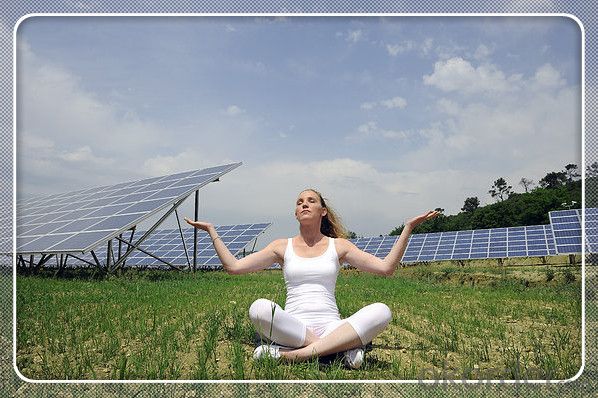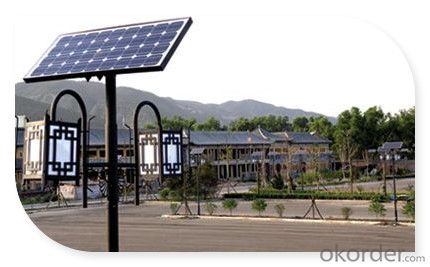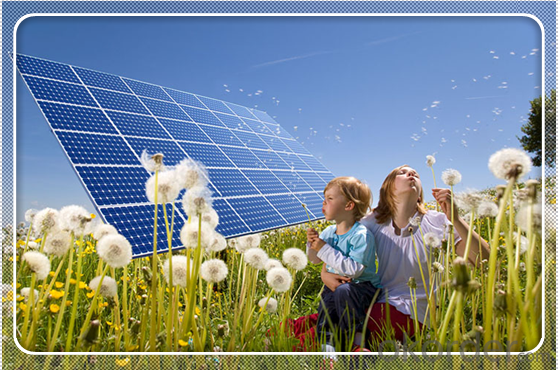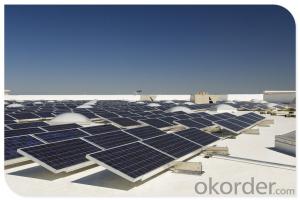60W Efficiency Photovoltaic Chinese Solar Panels For Sale 5-200W
- Loading Port:
- China main port
- Payment Terms:
- TT OR LC
- Min Order Qty:
- 10000 watt
- Supply Capability:
- 100000 watt/month
OKorder Service Pledge
OKorder Financial Service
You Might Also Like
Item specifice




Solar Module Introduction
Solar Module is the core part of solar PV power systems, also is the highest value part of it. The function of Solar Module is to convert the sun's radiation to electrical energy, or transfer it to battery and store in it, or to drive the load running.
The Product has been widely used in space and ground, it mainly used for power generation systems, charging systems, road lighting and traffic signs areas. It could offer a wide range of power and voltage, and with high conversion efficiency, and long service life.
Solar modules use light energy (photons) from the sun to generate electricity through the photovoltaic effect. The majority of modules use wafer-based crystalline silicon cells or thin-film cells based on cadmium telluride or silicon. The structural (load carrying) member of a module can either be the top layer or the back layer. Cells must also be protected from mechanical damage and moisture. Most solar modules are rigid, but semi-flexible ones are available, based on thin-film cells. These early solar modules were first used in space in 1958.
Electrical connections are made in series to achieve a desired output voltage and/or in parallel to provide a desired current capability. The conducting wires that take the current off the modules may contain silver, copper or other non-magnetic conductive transition metals. The cells must be connected electrically to one another and to the rest of the system. Externally, popular terrestrial usage photovoltaic modules use MC3 (older) or MC4 connectors to facilitate easy weatherproof connections to the rest of the system.
Secification
Model Type | |
Peak Power-Pmax(W) | 5-200W |
Open Circuit Voltage-Voc(V) | 44.2 |
Maximum Power Voltage-Vmp(V) | 36 |
Short Circuit Current-Isc(A) | 5.4 |
Maximum Power Current-Imp(A) | 5 |
Maximum System Voltage | 1000V DC |
Maximum Series Fuse Rating | 10A |
Power Tolerance | -1~+3% |
Temperature Coefficients of Pmax | -0.45%/℃ |
Temperature Coefficients of Voc | -0.348%/℃ |
Temperature Coefficients of Isc | 0.031%/℃ |
Nominal Operating Cell Temperature | 44.5±2℃ |
Standard Testing Condition(STC) | Irradiance:1000W/m²;Temperature:25℃;AM=1.5 |
Qualification Test Parameters | |
Operating Temperature | -40℃~+85℃ |
Storage Temperature | -40℃~+85℃ |
Pressure Bearing | ≥5400Pascal/m² |
Wind Bearing | ≥5400Pascal/m² |
Mechanical Characteristics | |
Cell Size | Mono 125*125mm±0.5 |
No.of Cells | 72pcs(6*12) |
Dimension | 1580*808*40mm |
Weight | 15.5Kg |
Glass | 3.2mm High Transmission,Low Iron |
Frame | Anodized Aluminum Alloy |
Junction Box | IP65Rated |
Internal Diodes | 3 Bypass Diodes |
Cable | 1*4.0mm² Length 900mm |
Images
Packing & Shipping:
We have rich experience on how to pack the panels to make sure the safety on shipment when it arrives at the destination.
The normal size is packed by 25pcs/ carton / pallet. Paper carton for FCL shipping and wood carton for LCL shipping.
Warranty:
For c-Si panel: 25years output warranty for no less than 80% of performance, 10 years output warranty for no less than 90% of performance. Free from material and workmanship defects within 5 years.
For a-Si panel: 20 years output warranty for no less than 80% of performance, 10 years output warranty for no less than 90% of performance. Free from material and workmanship defects within 2 years.
FAQ:
(1)What price for each watt?
It depends on the quantity, delivery date and payment terms.
(2)What is your size for each module? Can you tell me the Parameter of your module?
We have different series of panels in different output, both c-Si and a-Si. Please take the specification sheet for your reference.
(3)Can you provide the peripheral products of the solar panels, such as the battery, controller, and inverter? If so, can you tell me how do they match each other?
Actually we are only manufacturer of solar panels, but we could try to source them for you in China if you need. We could provide you an optimal system design to instruct you how to install.
(4)Do you have the CE, TUV, UL Certification?
We’ve already passed all the tests, and any certificate is available.
(5)Have you ever sold your products to companies in my country?
Of course, we have customers in all general PV markets, but I think we should expand our market share along with the market growth.
(6)When did your company set up? You are a new company, how can I believe your quality?
We entered into Solar PV industry in 2005, now we have several plants in manufacturing of a-Si and c-Si panels, and our capacity is 220MW per year. Till now we have already passed all the tests by authorized laboratories, e.g. TUV, VDE, UL.
(7)Can you help us install the module if we cooperate with you?
We haven’t entered into installation sector, but we have the plan in near future.
(8) How do you pack your products?
We have rich experience on how to pack the panels to make sure the safety on shipment when it arrives at the destination.
(9) Can you do OEM for us?
Yes, we can.
(10)Can we visit your factory?
Surely, I will arrange the trip basing on your business schedule.
- Q:So I reckon it's time to install some of these bad boys. it's come to point where electricity providers are charging such extortionate amounts that I can definitely see these reaping huge rewards before long. (Okay I might be exaggerating a little - they are pretty costly themselves).The problem is I've read around that they're only fitted to south facing houses? Why so? Why can't they be installed on the rear side of the roof - the side facing the garden? My house is facing north, so the front door leads north. Could I have solar panels installed on the back? (That's basically my question, with a bit of a rant too lol).Cheers.
- You want the panels facing south because that is where they would get the most sunlight throughout the day. If your front door is facing north, then the back of your house would be facing south, right? So put them up in the back where they are facing south...haha wtf..
- Q:I am doing research for a project.Please reply soon! :)
- Here's solar photovoltaics: They not only look different, they act completely differently!
- Q:How much does 000 square feet of solar panels cost? This is for a pool with dimensions 75ft by 25ft? How much will it cost including installation fee and the water heater?
- My Father-in-Law had around 300sqft of solar panels installed for the equivalent of around ?3000 or $5000. These were just the cheap and relatively inefficient black plastic tubes that were installed on his roof. This was in South Africa where the labour rates are quite cheap. The system works okay and heats a 40ft x 20ft outdoor pool to over 30C in the height of summer. Rather than a pool heater, I think it might be good to look at an air source heat pump to help heat the water in Autumn/Winter when you don't get enough sun to heat the pool. These will be expensive (over $5000), but they will use less than 30% of the electricity of a standard electric water heater. Just the solar panels could cost you $5-20K including fitting.
- Q:Most solar panels (the flat ones that go onto roofs of houses) reject electricity produced by the panels if they are too low in voltage. For example, on a cloudy day, although the panels may still get some sunlight to produce some electricity, it is rejected because its too low in voltage. So, does anyone have any ideas?
- Put one more panel in series with other one to increase the voltage output during cloudy day.
- Q:i need to cut down on electricity bills, and so i was wondering if someone could give me step-by-step instructions, or websites that have step-by-step instructions on how to build an electricity generating solar panel.
- Build from scratch, sorry your way over your head. (mine too). There are lots of companies that will give quotes on doing what your looking for, but plan on spending 20 to 50K depending on where you live and what you need. I don't know about where you are, but My hydro bill is almost half delivery charges. Therefore I could cut back by 99% on the usage, and still only have my bill come down by less than 50%. I understand you desire to lower costs, but unless you do a big change(lots of outlay) your savings will be small. By all means shut off lights your not useing etc. there are other ways of lowering your household bills better way is solar heating. But this also depends on where you live. I'm building a solar collector for 2 houses , Contact me at and I'll pass on more info
- Q:The battery is 9ah and the solar panel is 20w
- despite the statements to the contrary, using a solar panel to charge a battery is not rocket science. first lets look at you panel. panels normally have a spec for open circuit voltage (probably 20 volts for yours) operating power (4.4 volts at .4 amps is usual for 20 watt panel) and short circuit current (probably 2 amps in your case). if this panel is connected to a 2 volt battery, it will develop 20 watts of charge current in full sun. if this panel is connected to a 6 volt battery, it will work closer to the short circuit current or about .8 amps. doing the math this is a 7.2v x ,8= 3 watt charger for 6 volt batteries. while it is less efficient than when working at 2 volts, it will still work pretty good and no regulator is needed if you remember to disconnect the panel after 5 hours of full sun. if you want to walk away and have it run automatically, then you will need to find a 6 volt charge controller.
- Q:Can solar panels be installed on a swimming pool?
- Yes, solar panels can be installed on a swimming pool. These panels can be used to heat the water in the pool, reducing the need for traditional heating methods and saving energy costs. Additionally, solar panels can also be used to power pool pumps and other equipment, making swimming pools more energy-efficient.
- Q:What is the average annual energy output of solar panels that can be installed on the home?
- The output of a solar panel would depend on your location and panel size. Most solar panels are rated using 000 Watts per square metre from the sun. This is only possible at the equator. Some supplier have online estimators for output depending on your location. Solar panels rate up to about 250 Watts per panel. I have an online calculator to work out the costs and benefits of solar. You can compare the costs of solar setup and 25 years of electricity versus buying from the grid.
- Q:Can I add more solar panel let say up to 200 watt and adding two 2 volts battery using the same charges controller and power inverter?
- If you put a black panel on the ground or on your house and don't connect it to anything, it will absorb solar energy (heat) during daylight and release it at night (radiation). Not exactly. Assuming the black panel establishes an equilibrium temperature, it's going to be losing exactly as much heat as it's receiving during the day. Some will radiate out into space, some will conduct or convect into the atmosphere. As a wild guess, maybe 50/50. If you hook up a solar panel in the same place but hook it up to batteries, charge the batteries during sunlight hours and using that energy to electrically heat the home at night. The panels will absorb solar energy during the day but will convert that to electrical energy in the batteries instead of radiating it back into space at night. The panels are only about 4% efficient, so it's the same situation as the pure black panel for 86% of the energy. The remaining 4% will get stored in the batteries and then converted to heat at night. That heat will eventually leak out of the house and warm up the Earth a tiny bit. I think it's much the same situation either way. With the black panel the energy gets radiated / conducted/convected right away. With the solar panel a small percentage is stored and not so much is radiated, mostly conducted and convected. You're partly right as a black panel is going to radiate more into space than a house. But you're taking about maybe some day about 4% of % of the differening radiation/convection/conduction fraction, of the Earth's surface area. Probably not significant.
- Q:Can solar panels be used in areas with high levels of shade?
- Solar panels can still be used in areas with high levels of shade, but they may not be as efficient as in areas with direct sunlight. The shade reduces the amount of sunlight reaching the panels, which decreases their overall performance. However, with advancements in technology, some panels are designed to handle shade better than others. Additionally, proper installation and placement of the panels can help optimize their performance even in shaded areas.
1. Manufacturer Overview |
|
|---|---|
| Location | |
| Year Established | |
| Annual Output Value | |
| Main Markets | |
| Company Certifications | |
2. Manufacturer Certificates |
|
|---|---|
| a) Certification Name | |
| Range | |
| Reference | |
| Validity Period | |
3. Manufacturer Capability |
|
|---|---|
| a)Trade Capacity | |
| Nearest Port | |
| Export Percentage | |
| No.of Employees in Trade Department | |
| Language Spoken: | |
| b)Factory Information | |
| Factory Size: | |
| No. of Production Lines | |
| Contract Manufacturing | |
| Product Price Range | |
Send your message to us
60W Efficiency Photovoltaic Chinese Solar Panels For Sale 5-200W
- Loading Port:
- China main port
- Payment Terms:
- TT OR LC
- Min Order Qty:
- 10000 watt
- Supply Capability:
- 100000 watt/month
OKorder Service Pledge
OKorder Financial Service
Similar products
New products
Hot products
Hot Searches
Related keywords





























